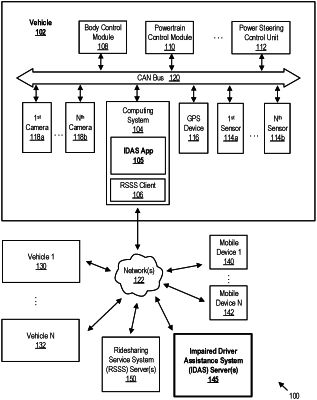| CPC B60W 60/0059 (2020.02) [B60W 40/08 (2013.01); B60W 60/0016 (2020.02); B60W 60/0018 (2020.02); B60W 60/0025 (2020.02); B60W 60/0051 (2020.02); G01S 19/42 (2013.01); G06N 5/04 (2013.01); G06N 20/00 (2019.01); B60W 2040/0836 (2013.01); B60W 2420/42 (2013.01); B60W 2540/26 (2013.01)] | 18 Claims |

|
1. A system comprising:
at least one processing device; and
memory containing instructions configured to instruct the at least one processing device to:
receive, from a plurality of cameras, first data derived from at least one visual feature of a user in a vehicle, wherein the at least one visual feature is recorded during a predetermined time period by a first camera in response to the user entering the vehicle, and further derived from at least one visual feature of surroundings of the vehicle recorded by a second camera, and wherein the first camera has a field of view configured to capture features of the user from locations inside the vehicle other than a driver seat;
determine, using a first artificial intelligence (AI) system having an input based on the received first data, at least one state of the user, wherein the first AI system is trained using other data for the user stored in a database during a training period in which the user is previously in the vehicle, wherein input for the training further comprises image data of other users and corresponding states for the other users; and
based on the determined at least one state and using a second AI system having the determined state as input:
order a rideshare for the user,
enable at least one first function of the vehicle, and
disable at least one second function of the vehicle, including locking or positioning the driver seat to indicate to the user that the user should not be driving;
wherein the instructions are further configured to instruct the at least one processing device to train the first AI system after a predetermined number of identifications of the user as a driver of the vehicle.
|